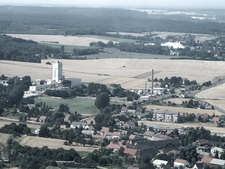Beendorf salt pile not suitable for backfilling of Morsleben
The Federal Office for Radiation Protection (BfS) has conducted examinations of the around 100-year-old salt pile in Beendorf. The objective was to assess whether the available material would be suitable for backfilling works to be carried out later on for the decommissioning of the Morsleben repository for radioactive waste applied for. The examinations have shown that the pile material cannot be used for the production of salt concrete for the backfilling of the repository.
Examination of the salt pile and analysis of the material composition
In 2008 and 2009, the BfS conducted examinations of the salt pile in Beendorf. In the process of these works
- the pile surface was examined by means of geophysical measurements in the surroundings of the pile and on the pile,
- two excavator prospecting works were established on the pile surface, and
- three sounding drillings were carried out from the pile surface into the pile underground.
The material taken in the examinations was tested for its composition. The analyses should provide information as to whether the pileed material would be generally suitable for works to backfill the repository to be carried out later on.
Furthermore, the BfS could gain findings about the technology required for a possible removal of the pile.
Results of material analysis
The material analyses have shown that the pile material cannot be used as basic material for the production of salt concrete. Its magnesium content is so high that the necessary solidity and the requirements on the long-term stability (in German only) of the salt concrete cannot be guaranteed. Thus, it is not possible for the BfS to use the material and to remove the pile.
Formation of the salt pile in Beendorf
Filling up the salt pile started with the material from the sinking of the Marie shaft. Some years later, additionally the residues from the processing of the potash salts produced in the Marie and Bartensleben mines – the so-called residual salts – were stockpiled. The salt pile covers an area of 2 hectares and has a volume of about 200,000 cubic metres.
State of 2015.04.28


